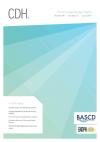Community Dental Health

- Cover Date:
- June 2017
- Print ISSN:
- 0265 539X
- Vol:
- 34
- Issue:
- 2
Relationship between mental health risk factors and oral symptoms in adolescents: Korea Youth Risk Behavior Webbased Survey, 2013
Objective: To investigate the relationship between mental health risk factors and Korean adolescents’ oral health. Basic research design: Cross--sectional study was based on the 9th Korea Youth Risk Behavior Web-based Survey (2013). Participants: Data were selected for 66,951 adolescents (33,777 males and 33,174 females; aged 13-18 years) out of 72,435 participants were analysed, after excluding cases with missing values. Main outcome measures: Oral health (experience of one or more of six oral symptoms), demographic characteristics (seven factors), and mental health risk (five factors). Method: Logistic regression analysis determined the effects of mental health risk factors on subjects’ oral symptoms after adjustment for general characteristics. Results: The adjusted
odds ratio (AOR) was 1.52 (95%CI 1.50,1.54) for sleep satisfaction self-described as “not sufficient at all†and AOR 2.64 (95%CI 2.59,2.69) for those reporting very high stress levels. The AOR was 1.26 times (95%CI 1.24,1.27) higher for those using the internet on weekends for non-study purposes for >6 hours than those using it for one hour. The AOR for experiencing oral symptoms was 1.44 times (95%CI 1.41,1.47) higher for those who had experienced school violence than for those who had not. Conclusions: Mental health risk factors were associated with oral symptoms. These results should inform the development of school health policies and comprehensive adolescent health promotion programs in Korea.
Key words: adolescent, mental health, oral health, psychological stress, sleep, Republic of Korea
doi:10.1922/CDH_3954Do05
- Article Price
- £15.00
- Institution Article Price
- £
- Page Start
- 88
- Page End
- 92
- Authors
- K.Y. Do, K.S. Lee
Articles from this issue
- Title
- Pg. Start
- Pg. End
- Communities in action: developing a dental ambassador training programme for adults with learning disability
- 77
- 79
- Public health intervention over four decades for the children in the Australian Capital Territory: Have we reached the point of diminishing returns?
- 84
- 87
- Relationship between mental health risk factors and oral symptoms in adolescents: Korea Youth Risk Behavior Webbased Survey, 2013
- 88
- 92
- PeP-SCOT a health coaching intervention for people in prisons: the development of the intervention protocol
- 97
- 101
- Productive efficiency and its determinants in the Community Dental Service in the north-west of England
- 102
- 106
- Socio-demographic and area-related factors associated with the prevalence of caries among preschool children in Greece.
- 112
- 117
- Dental caries experience, rather than toothbrushing, influences the incidence of dental caries in young Japanese adults
- 118
- 121
